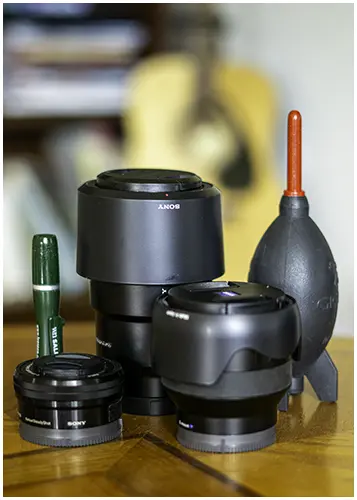
The Charming Northfield Falls in the Heart of Beach Estate Park
Looking to kill off an hour while in Nanaimo, BC? Just a short hop-skip and


Ever wondered why your photos sometimes appear blurry or hazy? It might be due to fingerprints, dust, or smudges. Keeping your lens clean is essential for capturing sharp, quality photos. Proper maintenance will not only result in crisp, dust-free photos, but your lens will last longer! Here’s our guide on how to clean your camera lens and safeguard your investment.
To determine if your camera lenses require a routine cleaning, it is important to inspect them for any indications of dirt and smudges. Here are the steps to follow:
In order to change the focus, switch your camera to manual mode and rotate the focus ring to infinity. This will enable you to view particles of dust in the viewfinder.
Locate a flat surface and capture a photograph of it. To ensure precise outcomes, it’s best to adopt the two-shot technique when cleaning your camera lens. Snap a picture of both a light-coloured and a dark-coloured surface in order to easily identify any dust particles present in the images. I take a photo of a neutral-coloured wall.
Review each image by zooming in on the photo. Thoroughly check for any dust spots or debris. If you come across any dirt, it’s time to clean your DSLR lens.
To ensure your lens is free of dust and smudges, it’s important to inspect the rear element. Be sure to also check for any mould on the inside of the lens. If mould is present, I recommend you have a professional cleaning service remove the mould rather than attempt to do so yourself.
Maintaining the condition of your lenses is a simple and easy process, provided you have the appropriate cleaning kit. It is important to invest in quality cleaning tools.
These are the essential items that you need to have in your camera cleaning kit:
Using your breath to remove dirt from the lens can be damaging, as the acidic components in your breath may harm the lens coatings. A safer alternative for eliminating dust on a lens is to use a manual air blower, which effectively removes any specks of dust.
It is important to have a blower in your camera bag when you are travelling or capturing photos outdoors, ensuring you are prepared to quickly clean your camera lens, especially the front lens. Yes, I have one in my bag. I own a Sony, and it collects dust like a magnet.
For cleaning your delicate camera lens, it is recommended to use a soft-bristled brush made with camel or goat hair. This will prevent any scratches from occurring. Additionally, make sure to avoid touching the bristles with oily fingers to avoid smudging the lens after brushing.
It is important to immediately dispose of camera-lens wipes after use. Reusing them may result in the transfer of dirt onto your lens once again.
When using a microfiber cloth to clean your camera or lens, it is important to ensure that it is clean. Avoid using fabric softener when washing the cloth, as the chemicals in it can potentially cause streaks and harm the coating on your lens.
What is a lens pen? It’s a multi-tool; at one end is a soft brush used to wipe the dust, and on the other end is a carbon cleaning element that removes fingerprints and smudges. Yup, I always carry it in my camera bag. PS: Yes, the carbon element does wear out.
To effectively remove fingerprints and smudges, it is important to use a lens cleaning solution that does not leave any streaks. Only a small amount of fluid, such as a drop or two, should be applied. It is advised to avoid using excess fluid on the cleaning cloth, as this can potentially harm the camera’s optics by allowing the fluid to seep inside.
While you have all the implements out to clean your lens, you might as well clean your filters at the same time.
Pro-Tip
To maintain your DSLR lenses and ensure they are in optimal condition, you can use the following straightforward step-by-step guide for cleaning:
When cleaning your lens, remember to also clean the lens caps.
Pro-Tip
Once you are familiar with the process of cleaning your camera lens, here are a few suggestions to help you keep your lens clean and well-maintained using the right way to clean with lens tissue and lens cleaner.
It is always more beneficial to prevent a problem, such as a dirty lens, rather than try to fix it. Along with maintaining a clean lens, it is also important to reduce the accumulation of dust on it.
To avoid dust particles from landing on the DSLR sensor and lens, make sure that both the camera and the lenses are facing downward when changing lenses. Return the cap to the lens before swapping to another lens. Keep the lens cap out of your dirty pocket. Did you know that most of the dirt and dust accumulating on your lens is from the lens cap?
Using canned or compressed air can potentially damage and ruin the camera sensor and lens optics, especially if directed towards the edge of the lens. To remove dust from your lens, opt for a manual air blower instead. This method, using a manual blower for cleaning the lens, is safer as the air expelled is not as highly pressurized as canned air, thus protecting the lens body and edge of the lens from potential damage.
Shh... I sometimes use compressed air to clean the lens cap. I've heard of individuals who place their lens caps in the dish washer; although I don't recommend this method, someday I might just try it.
Pro-Tip, Kinda
Regularly clean your lens mount to prevent dirt and dust particles from adhering to the rear of your DSLR lens, keeping the edge of the lens free from debris. By promptly removing any dust or dirt, you can reduce the likelihood of these particles reaching the optics of your camera lens.
I clean my lens mount with an alcohol swab; I never ever use WD-40.
The frequency of cleaning camera lenses is equally crucial as the method of cleaning them. It is advisable to only clean your camera lens when necessary and minimize the frequency of cleaning. However, certain circumstances may demand multiple cleanings in a day or even during a single photo shoot.
Before starting to take photos, it is important to inspect the front element of your lens after removing the lens cap. Check for any dust, smudges, lint, or water spots, and ensure to clean the camera lens if necessary.
Before attaching a new lens to your camera, it is important to inspect both the front and rear lens elements. In case you find any smudges or dust on the rear element, make sure to clean it before mounting the lens onto your camera body. Failure to do so may result in introducing debris to the interior of your camera or the sensor.
If you are taking photos while it is raining, on a windy day, or in any other situation that could cause your equipment to become dirty or damaged, it is important to regularly inspect your lens and quickly clean your camera and lens if necessary.
When it comes to cleaning a camera lens, the list of things you should avoid is much longer than the list of acceptable options. Below are the top cleaning substances and items that should be avoided, including any that can get dirty easily or introduce more dust or dirt to the lens.
It is important to never let any moisture enter the interior of your camera’s body. If you are uncertain about the proper method of cleaning a camera lens, it is recommended that you seek assistance from professionals.
Experienced technicians who specialize in repairing and cleaning cameras make use of lint-free tissue paper, microfiber cloths, puffs of air, and isopropyl alcohol for the purpose of cleaning both lenses and camera components. As long as the lenses are properly weather-sealed and the use of alcohol is carefully monitored, this method can be considered a safe practice for cleaning the front lens.
In conclusion, ensuring your camera lens stays clean is vital for capturing stunning, crisp photos. By following the steps outlined in this guide on how to clean your camera lens, you can maintain the quality of your images and prolong the lifespan of your equipment. Remember to conduct regular dirt tests, invest in quality cleaning tools, and adhere to proper cleaning procedures. Here’s a quick recap of the key points:
Conduct routine dirt tests to identify any smudges or debris on your lens.
Invest in essential cleaning tools like an air blower, soft-bristled brushes, lens wipes, a microfiber cloth, and a lens pen.
Follow a step-by-step process for cleaning your lens, ensuring you remove dirt and smudges effectively.
Implement preventive measures to keep your lenses clean, such as attaching lens caps, storing lenses in a clean environment, and cleaning the lens mount.
Avoid using harsh cleaning agents or tools that could damage your lens, and never let moisture enter the interior of your camera body.
By incorporating these practices into your photography routine, you can maintain a clean and well-functioning camera lens, resulting in stunning, high-quality photographs every time.
To clean your camera lens, you can use tools like an air blower, soft-bristled brushes, lens wipes, microfiber cloth, or a lens pen. Avoid harsh cleaning agents and moisture to prevent damage.
Yes, you can use alcohol wipes on camera lenses, but exercise caution. Ensure lenses are properly sealed, and use isopropyl alcohol sparingly to avoid damage. Always consult professionals if uncertain.
Yes, alcohol wipes can be safe for lenses if used properly. However, it’s crucial to ensure they are specifically designed for lens cleaning and contain isopropyl alcohol. Avoid harsh chemicals that could damage lens coatings. Always exercise caution when using any cleaning solution on delicate camera equipment.
Yes, isopropyl alcohol can damage camera lens coatings. Avoid using it unless it is recommended by a professional. Opt for safer cleaning alternatives to preserve your lens’s quality and lifespan.

Looking to kill off an hour while in Nanaimo, BC? Just a short hop-skip and

Photography can be a fulfilling and enjoyable hobby that brings a creative outlet to your

Welcome to our guide to Photoshop tutorials for beginners: A Complete Beginner’s Tutorial for Learning